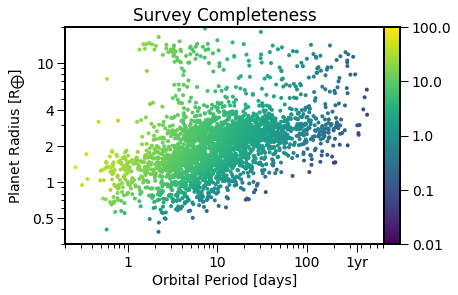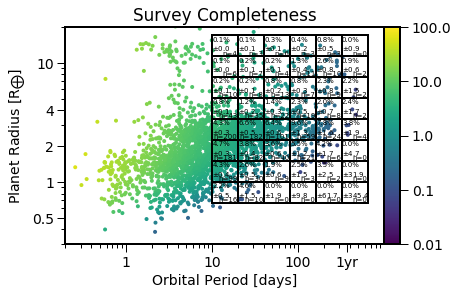Occurrence Rates¶
Estimate planet occurrence rates using the inverse detection efficiency method.
This example calculates the occurrence rates for different classes of planets, defined by a size and period-range
[1]:
import EPOS
import numpy as np
import matplotlib.pyplot as plt
initialize the EPOS class with the kepler dr25 exoplanet survey
[2]:
epos= EPOS.epos(name='occurrence_rate_inverse', survey='Kepler')
|~| epos 3.0.2 |~|
Initializing 'occurrence_rate_inverse'
Using random seed 1678722249
Survey: Kepler-Gaia all dwarfs, reliability > 0.9
Calculate the survey completeness for each planet
[3]:
EPOS.occurrence.planets(epos)
EPOS.plot.occurrence.colored(epos, NB=True)
Interpolating planet occurrence

Define a set of period (x) and radius (y) bins to calculate occurrence rates for Hot Jupiters, Super Earths, and Mini-Neptunes
[4]:
# Hot-Jupiters
Period_HJ= [1,10] # days
Radius_HJ= [8,16] # earth radii
# super-earths
Period_SE= [0.5,50] # days
Radius_SE= [0.7,1.8] # earth radii
# mini-Neptunes
Period_MN= [2,300] # days
Radius_MN= [2.0,4.0] # earth radii
epos.set_bins(xbins=[Period_HJ,Period_MN, Period_SE],
ybins=[Radius_HJ, Radius_MN, Radius_SE])
Calculate the occurrence rates and visualize them
[5]:
EPOS.occurrence.binned(epos)
EPOS.plot.occurrence.colored(epos, Bins=True, NB=True)
Observed Planets
x: [1,10], y: [8,16], n=55, comp=0.12, occ=0.0043
x: [2,300], y: [2,4], n=1093, comp=0.039, occ=0.52
x: [0.5,50], y: [0.7,1.8], n=1018, comp=0.072, occ=0.31

Looks like there are many more super-earths and mini-Neptunes than Hot Juiters!
Now let’s calculate occurrence rates on the SAG13 grid
[6]:
epos.set_bins(xgrid=np.geomspace(10,640,7),
ygrid=np.geomspace(0.67,17,9), Grid=True)
EPOS.occurrence.all(epos)
Interpolating planet occurrence
Observed Planets
x: [10,20], y: [0.67,1], n=16, comp=0.0072, occ=0.022
x: [20,40], y: [0.67,1], n=10, comp=0.0023, occ=0.046
x: [40,80], y: [0.67,1], n=0, comp=nan, occ=0
x: [80,160], y: [0.67,1], n=0, comp=nan, occ=0
x: [160,320], y: [0.67,1], n=0, comp=nan, occ=0
x: [320,640], y: [0.67,1], n=0, comp=nan, occ=0
x: [10,20], y: [1,1.5], n=99, comp=0.021, occ=0.043
x: [20,40], y: [1,1.5], n=30, comp=0.011, occ=0.026
x: [40,80], y: [1,1.5], n=9, comp=0.005, occ=0.019
x: [80,160], y: [1,1.5], n=3, comp=0.001, occ=0.025
x: [160,320], y: [1,1.5], n=2, comp=0.00047, occ=0.035
x: [320,640], y: [1,1.5], n=0, comp=nan, occ=0
x: [10,20], y: [1.5,2.3], n=181, comp=0.033, occ=0.047
x: [20,40], y: [1.5,2.3], n=82, comp=0.018, occ=0.038
x: [40,80], y: [1.5,2.3], n=40, comp=0.01, occ=0.036
x: [80,160], y: [1.5,2.3], n=21, comp=0.0036, occ=0.055
x: [160,320], y: [1.5,2.3], n=6, comp=0.0013, occ=0.042
x: [320,640], y: [1.5,2.3], n=0, comp=nan, occ=0
x: [10,20], y: [2.3,3.4], n=200, comp=0.039, occ=0.043
x: [20,40], y: [2.3,3.4], n=182, comp=0.023, occ=0.066
x: [40,80], y: [2.3,3.4], n=101, comp=0.013, occ=0.064
x: [80,160], y: [2.3,3.4], n=59, comp=0.0055, occ=0.096
x: [160,320], y: [2.3,3.4], n=24, comp=0.0026, occ=0.078
x: [320,640], y: [2.3,3.4], n=4, comp=0.00088, occ=0.038
x: [10,20], y: [3.4,5.1], n=43, comp=0.044, occ=0.0082
x: [20,40], y: [3.4,5.1], n=35, comp=0.024, occ=0.012
x: [40,80], y: [3.4,5.1], n=22, comp=0.014, occ=0.014
x: [80,160], y: [3.4,5.1], n=19, comp=0.0069, occ=0.023
x: [160,320], y: [3.4,5.1], n=8, comp=0.0034, occ=0.02
x: [320,640], y: [3.4,5.1], n=2, comp=0.00071, occ=0.024
x: [10,20], y: [5.1,7.6], n=10, comp=0.047, occ=0.0018
x: [20,40], y: [5.1,7.6], n=8, comp=0.027, occ=0.0024
x: [40,80], y: [5.1,7.6], n=13, comp=0.014, occ=0.0077
x: [80,160], y: [5.1,7.6], n=7, comp=0.0078, occ=0.0076
x: [160,320], y: [5.1,7.6], n=9, comp=0.0033, occ=0.023
x: [320,640], y: [5.1,7.6], n=2, comp=0.00075, occ=0.022
x: [10,20], y: [7.6,11], n=6, comp=0.049, occ=0.001
x: [20,40], y: [7.6,11], n=7, comp=0.028, occ=0.0021
x: [40,80], y: [7.6,11], n=4, comp=0.016, occ=0.0022
x: [80,160], y: [7.6,11], n=11, comp=0.007, occ=0.013
x: [160,320], y: [7.6,11], n=10, comp=0.0034, occ=0.026
x: [320,640], y: [7.6,11], n=2, comp=0.0019, occ=0.0088
x: [10,20], y: [11,17], n=4, comp=0.045, occ=0.00074
x: [20,40], y: [11,17], n=3, comp=0.028, occ=0.00089
x: [40,80], y: [11,17], n=6, comp=0.016, occ=0.0032
x: [80,160], y: [11,17], n=3, comp=0.0068, occ=0.0036
x: [160,320], y: [11,17], n=3, comp=0.0032, occ=0.0082
x: [320,640], y: [11,17], n=0, comp=nan, occ=0
/Users/mulders/anaconda3/lib/python3.7/site-packages/numpy/core/fromnumeric.py:3257: RuntimeWarning: Mean of empty slice.
out=out, **kwargs)
/Users/mulders/anaconda3/lib/python3.7/site-packages/numpy/core/_methods.py:161: RuntimeWarning: invalid value encountered in double_scalars
ret = ret.dtype.type(ret / rcount)
[7]:
epos.plotpars['textsize']= 7
epos.xtrim[1]= 1000
EPOS.plot.occurrence.colored(epos, Bins=True, NB=True)

Save the binned rates to a file: json/occurrence_rate_inverse/occurrence.inverse.json
[8]:
EPOS.save.occurrence(epos)